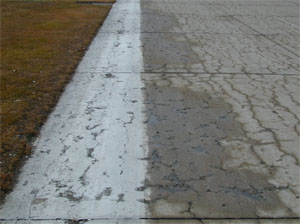- Michigan 2023 IDEA /
- Pavement Inspection /
- PCC Distress Measurement /
- Alkali-Silica Reaction (ASR)
Alkali-Silica Reaction (ASR)
Alkali-silica reactivity (ASR) occurs when the high pH of a concrete pore solution (due to the alkalis [Na2O and K2O] present in cement) results in the dissolution of certain reactive silica minerals in some aggregates. Once dissolved, this silica combines with the alkalis to form an alkali-silica reaction product (i.e., a gel type material), that expands in the presence of water causing the fracturing of the aggregates and paste. Pattern cracking is commonly the physical symptom of this expansion on the pavement’s surface, and it is usually observed over the entire slab surface. Other symptoms may include cracking and deterioration in the vicinity of joints, that is similar in appearance to “D” cracking and/or signs of expansion.
| Severity | Distress Example | Description |
|---|---|---|
| Low |  | Minimal to no FOD potential from cracks, joints or ASR-related popouts. Cracks at the surface are tight; predominantly 0.05 inch (1 mm) or less. Little to no evidence of movement in pavement or surrounding structures or elements. |
| Medium |  | Some FOD potential; increased sweeping or other FOD removal methods may be required. May be evidence of slab movement and/or some damage to adjacent structures or elements. Medium-severity ASR distress is differentiated from low by having one or more of the following: (1) increased FOD potential; (2) increased cracking of the slab; (3) some fragments along cracks or at crack intersections present; (4) surface popouts of concrete may occur; (5) pattern of wider cracks (predominantly 0.05 inch [1.0 mm] or wider) that may be subdivided by tighter cracks. |
| High |  | One or both of the following exist: (1) loose or missing concrete fragments which pose high FOD potential; (2) slab surface integrity and function significantly degraded, and pavement requires immediate repair. |